Blog
Lorem ipsum dolor sit amet, consectetuer diam nonummy nibh tincidunt.



by Admin
Posted on Sep 12, 2020 02:09 AM

The Covid-19 Pandemic has largely disrupted our social activities and what comes next will never be the same as before. The education sector is one out of those which has been adversely affected by the pandemic. Nevertheless, the industry can take this as a lesson well learnt and adopt new models to supersede its previous one. Now as the government of India has initiated the unlocking process, the next question which arises is how to adopt the New Normal.
How will be the new Normal for educational centres and learning institutes?
To answer this question we will need to evaluate the harsh realities the pandemic has inflicted on this industry. It is quite clear by now that schools, colleges and coaching institutes are the ones which are majorly impacted by the pandemic. Pre-schools, primary, upper primary schools and coaching centres are subjected to prolonged shutdowns. Schools and coaching centres located in suburban and rural areas are facing a demographically driven decline in demand and are either temporarily or permanently closed. Most of the educational centres will see a decline in its revenues and increase in costs. At this hour we can only hope that private unaided schools and learning institutes prioritize its faculty and other staffs, prevent layoffs as its budgets are reduced.
However, the post-pandemic landscape for Education Sector is not entirely bleak. Most education centres have adopted digital measures to keep delivering what they are supposed to. Many teachers and mentors have harnessed new skills and alternative approaches to keep up their teaching activity. We can anticipate two post-pandemic Hybrid pedagogy which educational centres and coaching institutes might be looking forward to adopting.
1. Online Lessons to cultivate Deep Learning and Offline classes to exercise the same
Online classes can be continued to teach core concepts, cover topics on subject matters and help students to understand the gist. While offline classes can include exercise, mocks, group discussions and dramatizations to expand the learning and encourage practical applications.
The necessity of teaching online with asynchronous and synchronous tools like canvas, D2L, google meets, zoom etc. will be resourceful when these experience and methods will be layered with the conventional method of teaching. The understanding and experience of these digital tools are complements to our traditional classroom learning method. Even though if these digital tools were a substitute for the traditional method of teaching during the pandemic, it can be combined together with the traditional teaching method to provide a quality learning experience.
2. Centralized Online Education for Schools of the same group
Most of the Schools and colleges were not focused on Online learning before the co-vid19 pandemic. Few schools and colleges didn’t even consider them necessary. However, during this pandemic, it is the basic requirement for any school to continue teaching. Even now when most of the schools have resorted to online teaching, a major gap exist in standardizing the quality of the content throughout the schools.
Post pandemic, most schools under the same group or society have an option to centralize the online learning process. A centralised system of Online classes, Tests, Study materials, video content etc which will ensure the uniformity of the level and quality of learning among the students. Post pandemic every President, Dean, Trustee and Faculties will understand that online learning is not only a potential source of income for the schools but will be considered as a core to every schools and college. The existing decentralized method of online teaching, course development and support functions can be centralized, which again is subjected to the cross-campus governance and planning.